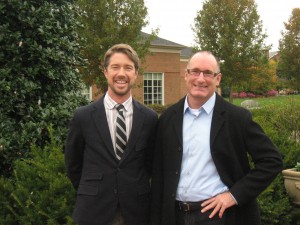The Incredible Power of One Sustainable Yard at a Time
by Adele MacLean, Program Developer/Special Projects & Jonah Holland, PR & Marketing Coordinator, Lewis Ginter Botanical Garden

The Gillette Forum, the last of Lewis Ginter’s four-part 25th anniversary symposia, was filled with many great stories, images and ideas about how each of us can do our part to create landscapes that are both beautiful and environmentally sustainable. After taking a moment to absorb it all, our special projects program developer and I have gathered our thoughts and reflections on the symposium. The Gillette Forum moved more than a few Virginians. How it Grows, a Williamsburg blog, has a great recap of our keynoter Douglas Reed’s presentation and of Timothy Beatley’s documentary ‘The Nature of Cities” Richmond premier at Gillette. So, if you missed the forum, be sure to check those out.
Today, I’ll let Adele MacLean, our special projects program developer, who worked tirelessly planning many of the intricate details of Gillette share her thoughts with you. I figured who better to tell you about the symposium than the woman behind the scenes. Tomorrow, I’ll share my reflections, so stay tuned! And stay tuned for a podcast recording of keynoter Douglas Reed as well. Here is Adele:
At the end of Thomas L. Woltz’s keynote speech, “Narratives of Ecology” keynote presentation at the Gillette Forum, all I could say to the friend across the table who caught my eye was a silent, “Wow.” What she mouthed in response was exactly the same: “Wow.”
I was dazzled again and again by both major speakers’ presentations and learned more than I would have imagined possible when I set out for the Garden that morning. I saw images and heard stories of thousands of acres of landscape in Virginia, Massachusetts, and New Zealand that were transformed by exemplary collaborations among professionals from various disciplines and visionary landowners who took extraordinary measures to protect wildlife, plant communities, and water quality, to respect history and culture, and ultimately to create landscapes that were not only achingly beautiful but also responsible. After that consciousness-raising experience, “sustainability” took on a new meaning for me.
And yet . . . the same question began nagging me that apparently bothered other members of the audience. Someone raised it during the Q & A that followed the two Thursday morning presentations—what if I don’t own hundreds of acres of land in rural Virginia or New Zealand but just have one small plot in suburban Richmond? What if I don’t have vast resources to team up with landscape architects, biologists, botanists, hydrologists and all the others to probe every detail of my property’s cultural and ecological context? Does sustainability matter only at that scale or does what I do in the small space where I live make a difference, too?
That’s when Thomas Woltz impressed me most of all. He answered passionately that small landowners like me have the greatest impact on the natural environment and therefore can make the biggest difference in determining whether it will be sustainable, because our holdings aggregated together amount to far more than any of the wealthy landowners’ projects he had highlighted in his presentation. He pointed out that simple decisions we make about our property, such as whether to purchase a popular but invasive plant or to create an expansive lawn, can make the difference between promoting healthy wildlife habitat or further endangering a plant or animal species. He ended by charging each of us to try to understand what is unique about the places where we live, to be sensitive to the “narratives of ecology” in our own backyards, and to make responsible decisions based on what we learn so that we, too, can become effective stewards of the environment.
In a word, our job is to heal the planet one yard at a time.